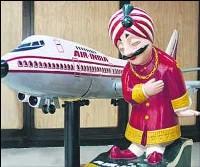 | « Back to article | Print this article |
Air India's turnaround plan, which has been reviewed by consulting firm Deloitte and accepted by the airline's board, says the company will start making operating profit from this financial year itself. Air India has been running under losses since 2007. The new plan envisages monetising of commercial assets, earning revenues from new joint ventures, like that for maintenance, repair and overhaul (MRO), leveraging the airline's bilaterals in South-East Asia and West Asia, and a sharp drop in its wage bill by shifting staff to new joint ventures.
The new plan envisages monetising of commercial assets, earning revenues from new joint ventures, like that for maintenance, repair and overhaul (MRO), leveraging the airline's bilaterals in South-East Asia and West Asia, and a sharp drop in its wage bill by shifting staff to new joint ventures.
According to the plan, Air India will make an operating profit of Rs 449 crore (Rs 4.49 billion) in 2011-12 on operating revenues of Rs 16,525 crore (Rs 165.25 billion).
The operating revenues will increase to Rs 33,035 by 2014-15, when the airline is projected to make an operating profit of Rs 4,620 crore (Rs 46.20 billion). The operating expenses in the same period will go up from Rs 16,076 in 2011-12 to Rs 28,415 in 2014-15.
The plan envisages monetisation of commercial assets by the national carrier, which is projected to generate Rs 4,000 crore (Rs 40 billion) till 2014-15.
The assets that have been identified include the Air India building at Nariman Point in Mumbai, land at Nerul in Navi Mumbai, Airlines House on Baba Kharak Singh Marg in Delhi and flats at Vasant Vihar in Delhi.
Deloitte, however, has advised the airline that it needs to undertake a detailed assessment of its assets to calculate the net revenues that can be realised.
Air India also plans to earn income from its proposed joint ventures. Under the plan for a joint venture for setting up an MRO, the airline wants to share 20 per cent of the JV revenue from third party maintenance contracts in lieu of transfer of assets of Air India to the new JV at Rs 1.
Air India also hopes to reduce its wage costs dramatically, from 24 per cent of the total operating expense to only 13 per cent in 2012-13, and only 11 per cent in 2014-15.
As a result, its wage cost per available seat per kilometre (ASKM) will go down from a high of 92 paise currently to a third by 2014 (33 paise).
According to Deloitte, based on the airline's projection, the wage cost of Air India will be lower than those of Kingfisher and Jet Airways over the next five years, and only marginally higher than SpiceJet.
The consulting firm has advised the airline to carry out a thorough exercise to arrive at a more realistic estimate.
The firm has also said that the operationalisation of the JVs will be critically dependent on movement of the staff from the parent company. Besides, it wants the airline to examine again the financial sustainability of the proposed JV.
The report also quantifies the compensation expected from Boeing on account of delay in the deliveries of Boeing 787 at Rs 1,680 crore (Rs 16.8 billion).
Air India is also making a major push into the South-East Asian and West Asian markets. It proposes to deploy a capacity of 2.71 million seats over the India-South-East Asia corridor by 2014-15.
It says the foreign carriers flying to India will exhaust their bilaterals by 2012, based on the current capacity growth. But, as Air India would still have unutilised bilaterals, it could take advantage of the projected growth of 10.1 per cent in this market.
Similarly, in West Asia, the foreign carriers will exhaust their bilaterals by 2013, giving Air India an opportunity to use its unutilised capacity in a market that is growing 8 per cent per annum.
In its goal to achieve a turnover of Rs 35,000 crore (Rs 350 billion) by 2014-15, the plan also proposes a major expansion of the fleet.
It wants to increase the airline's narrow-body fleet to 109 by 2015 from 72 now. During the same period, the wide-body aircraft will also increase from 30 to 54.